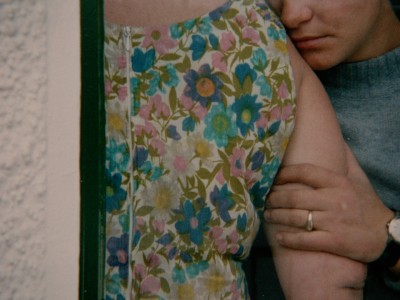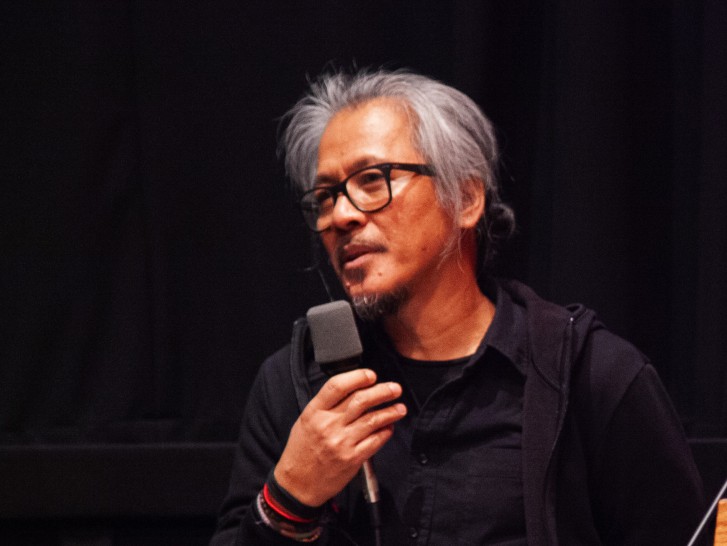
Century of Birthing (Siglo ng pagluluwal) introduction and post-screening discussion with Haden Guest, John Gianvito and Lav Diaz.
Transcript
Haden Guest 0:05
Good afternoon, and thank you all for being here. We really appreciate these turnouts, for films like this that are so rarely screened. And for those of you who share our deepest passions and convictions about what is important in cinema, the good weather doesn't matter, right? This is much more important. So thank you for being here.
This is the second of three in-person screenings of the work of the great Filipino master Lav Diaz, whose films we’ve screened on several different occasions now and he's returning, of course, as a Baby Jane Holzer Visiting Fellow in Film, and so he'll be in residence here at Harvard through midweek next, visiting classes, giving a masterclass, meeting with students and doing all sorts of activities that really fully integrate him into the vibrant community of filmmakers, artists, students that thrives here at Harvard.
I'm especially excited today because we're going to see Century of Birthing, which is an important epic work of Lav Diaz’ and it's a great opportunity to reconsider, I think, this sort of midpoint in this extraordinary career. And in doing so, we're really fortunate to have with us our good friend John Gianvito who is a professor at Emerson College and a filmmaker—important filmmaker—in his own right. And John Gianvito will be introducing the film and we'll also be having a conversation with Lav Diaz afterwards. So I'll ask you please to turn off any cell phones electronic devices that you have, please refrain from using them. And we will be having a thirty-minute intermission roughly midway through the film. And now with no further ado, please join me in welcoming John Gianvito who will in turn introduce Lav Diaz.
[APPLAUSE]
John Gianvito 2:05
Good day, everyone. So, I'm going to be brief. It’s not exactly a short film, although Lav has made longer films than six hour films. And, in fact, I'm not going to say very much about Century of Birthing, because I'm actually going to be watching it for the first time myself today. But when Haden invited me to say a few words, I was trying to think of something that might be fitting for the occasion. And something I was reading recently struck a real chord in me in terms of my experience of Lav as an individual and as an artist, and I thought I'd just quickly share that.
I wanted to just read a very short excerpt from a text—that I don't think is so well known—by Bertolt Brecht. And just backing up a little bit, perhaps some of you are aware that Brecht left Germany, the very day after the burning of the Reichstag February 1933, and still, you know, there are various theories about who was responsible for the incident, but what is certain is that that destruction of the German parliament was galvanized as a pretext for Hitler to further consolidate his power and to really launch the reign of terror of the Nazi Party.
So, Brecht packed up with his family and went to Prague and then to Europe eventually, elsewhere and to the US, but shortly after he left, he wrote this text and I’m just gonna read the first paragraph, but I recommend this to you if interested. It's called Writing the Truth, Five Difficulties.
“Nowadays, anyone who wishes to combat lies and ignorance and to write the truth must overcome at least five difficulties. First, he must have the courage to write the truth when truth is everywhere opposed. Second, the keenness to recognize it, although it isn't everywhere concealed. Third, the skill to manipulate it as a weapon. Fourth, the judgment to select those in whose hands it will be effective and last, the cunning to spread the truth among such persons. These are formidable problems for writers living under fascism, but they exist also for those writers who have fled or been exiled. They exist even for writers working in countries where civil liberties prevail.”
For me in his in his own conveying of uncomfortable truths, Lav Diaz’ cinema is what I think of as a “night vision” cinema, not literally in the use of the technique of night vision, but in the ability and the desire to peer into the deepest, darkest recesses of the human spirit, into our fears, into our weaknesses, into our dreams, into our addictions, our doubts. If you've experienced any of these films before, I think you know that this is a journey through often excoriating pain, through great heaviness. They offer us a vision of a world that often seems to have gone completely mad. And yet, these are films that aspire, as Lav said so eloquently last night to try to help us keep sane. I know that's what they do for me, and it's my great pleasure to welcome Lav Diaz.
[APPLAUSE]
Lav Diaz 6:39
Thank you for coming, you brave ones. [LAUGHS] There are like how many people here? Eight people? Yeah, I won't take much of your time. It's six hours, so... There's going to be a Q&A after the film.
I just want to tell you how I made this film. I was sitting by a little store in Manila, this was like 2010, or 2011. And the two guys who obviously were drunk, and then they were talking about the storm coming in one of the provinces in the Philippines. And suddenly, there's this idea about a madman, a mad poet was walking in the middle of the storm and he meets a pregnant woman. So that became the idea, the muse of the film, the [UNKNOWN] of the film. So I asked friends, the actress and actor, to come with me to go to the eye of the storm and start the film there. So the film was written backwards. So let's talk about it later. Thank you so much.
[APPLAUSE]
---------------------------------------------------------------------
Lav Diaz 8:07
Thank you for surviving.
John Gianvito 8:08
Yeah, you're all officially now warriors. That's Lav’s term for people who make it through to the ends of these films.
My first thought is that it's enough to accomplish a work like that, then to have to come and speak about it afterwards, you know, and I'm grateful that you're doing this. But I often think about the fact that as filmmakers, this is the ritual where you go to an art gallery opening and it doesn't ask the painter to come now and answer some questions, or... I remember one filmmaker saying at a festival, the director of the festival was saying, “Okay, so we're going to screen your film, and then there's going to be a Q&A with the audience.” And the filmmaker said, “A Q&A with the audience? What is the audience, the police? I don't need to be interrogated.” All of which to say is what I'd really like us to try to have in the limited time we have tonight is just a conversation where we can talk to you, you can talk to us. We can just share thoughts.
This is obviously a film that opens itself to many different kinds of readings of the elements that you've assembled here. And I thought perhaps a first way of entering into it is providing the audience perhaps with some of the context that they may or may not know about– You spoke about how the first scene happened, but the fact that there were three features of yours that were unfinished at the time that you were making this, including the one that we see excerpts from, Woman of the Wind, was an actual film that Lav was trying to move towards completion. And then I'm also reminded in the end credits that this was a film that was also being made during the emotional ordeal of the tragic passing of two friends of ours, Alexis Tioseco and Nika Bohink were a couple and wonderful critics who were murdered.
And so, you know, I recognize many echoes in the film of other works, but also many things that are kind of unique to this particular film. So much of your work is about the long melody of Philippine history and of the suppression of much of that history. And this is, sort of, a film about the malady of the filmmaker, himself.
So yeah, I don't know. It’s not quite a question yet, but as you hear me say those things, if you put yourself back in the time that you were trying to make this film, the struggles that you're having, I know was in part because actors were losing interest in the project or something like that—right?—with the other films. But also, there was something about your own struggle with your own inspiration and believing in yourself.
Lav Diaz 11:47
So many things happened prior to this work. Yeah, two of our friends died the year before. Alexis Tioseco and Nika Bohink, they’re very different, they're great critics and film scholars, and I took a long break. And at that point, I was trying to finish two films, The Woman Who Left and Heremias Book Two, the part two of the nine-hour film that I shot in 2006. And I had some questions and doubts about, you know, cinema. Is it worth dying for? Am I gonna pursue it? Am I just gonna go off to my farm in Mindanao, and till the land again, or go back to New York and take care of my kids and my grandson? You know, questions of identity and doubts or aesthetics, and the country was under a very, very corrupt woman president at that point, all this turmoil and fracturing of the psyche. They're happening and all at once. There's this new inspiration to do the work. It just happened. I was just having coffee like around 4:30 in the morning, very early. I went down and went to the store. And there are two drunk guys, and they're talking about a storm that's coming [to] the middle of the country. The province Tarlac is like, three, four hours away. Yeah, four hours away, and [UNKNOWN]. So the idea just came in my head, the image of a struggling artist, just walking in the middle of the storm, meeting a pregnant woman. It's like the insanity of King Lear in the middle of the storm. So that's a nice premise for a film, but I don't know how to do it, but I just want to shoot that scene. So I just called up Perry Dizon, the actor who did the part of Homer and then Hazel Orencio. Hazel said, “I’m trying to finish some laundry.” So “No, please come. We go to this place.” And Perry Dizon said “I’m going to the south. The plane is leaving in three hours.” I said, “Come! Stop that flight, man. Come.” So luckily, they came and then we went to the middle part of the country. This is the true bus. And we shot that scene.
John Gianvito 14:19
And this is the first film you're making with Hazel, correct?
Lav Diaz 14:23
No, it's the second film. The first one was Florentina Hubaldo. Yeah, the second film, so yeah.
John Gianvito 14:31
But she hadn't acted in any films before she worked with you. Is that right?
Lav Diaz 14:34
No, she acted, I think, on TV and theater, but mostly like an extra. You know, theater people, they go to TV as extras and they do things for the money because there is no money in theater in the country. So they do TV commercials. So that was the starting point in a mix of the turmoil and then suddenly there’s an inspiration to do things. So I have that kind of attitude in doing cinema. If there's a thread or an opening to do something, then I'll do it. I’ll just grab my camera because I have my cheap cameras with me and some friends who can help me. So we just took off and we rented a house in the middle part of the country, and I just started writing the story backwards. This is the end. So I told him, “This is the end of the film, so we have to move backwards.” So it's gonna happen. So every night there was writing and writing and writing, going crazy. And we started calling our friends to come and help. And slowly from just the two of us, it became ten people. [LAUGHS] It's a nine month work. We were doing the film for nine months.
John Gianvito 15:55
Nine months is appropriate!
So one of the threads is Homer's Odyssey.
Lav Diaz 16:03
Yeah, the struggle of the artist, yeah. The aesthetic struggle.
John Gianvito 16:06
We have the story in Woman of the Wind of—is it Angela?
Lav Diaz
The woman who is losing her faith, yeah.
John Gianvito
–who wants to have a physical connection with her body and the world, not just a spiritual one.
Lav Diaz 16:24
To understand the world, yeah.
John Gianvito 16:27
And then with Hazel's character, we have a woman who wanted to devote herself to spirituality and the world forces itself–
Lav Diaz 16:36
The neglected and exploited one.
John Gianvito 16:41
And the photographer who is never named, but there's a reading of the film that he's a, sort of, imagined character of Homer or potential future film that Homer might be working on as well.
And this theme of abortion also comes, which is the opposite of birth, in terms of that theme, and creation is the killing of life. And, then I also thought about the long history of Christian doctrine in the Philippines. Which the cult can sort of stand in for, in a way.
Lav Diaz 17:41
Colonization struggles.
John Gianvito 17:46
And I know a little about your childhood and growing up in Mindanao, and your parents being teachers, but I don't know that I know anything about whether they had any religious practice.
Lav Diaz 17:58
My mother was a devout Catholic, and my father was hardcore idealogue. He's a socialist. So I grew up in that kind of atmosphere, but my father respects my mother as a Catholic, and my mother respects the communist in my father. They're both public school teachers.
We settled in a very, very remote area of Mindanao where ther are two tribes, the Manobos and the Manguangan, these are indigenous peoples of Mindanao. They chose to live there to educate these people, so... We don't have electricity and no college. But I am really grateful that I grew up in that kind of environment, seeing stark poverty, the struggles of people, the issue of neglect with the system. And yeah, that informs how I see life. And how I also engage in my aesthetic pursuit in my cinema, particularly.
John Gianvito 19:11
And I suspect that part of that experience of your childhood given just physically where you were also informs the way in which– There's something I was thinking when I was watching this film that has a lot of resonance, not only with my own work, but I was thinking of Jean-Marie Straub who also often talks about how part of what his films are about is the fact that man is not the center of the universe. And nature really is one of the characters in your films.
Lav Diaz 19:41
Huge, huge character in my films, especially with the Malay culture. We're so attached to the ways of nature. In the Philippines, it's all nature. Like we have 28 typhoons, strong typhoons every year, so we’re really attached to that. So we always had that cycle of death and rebirth and devastation and regeneration, it's a cycle amongst Malay people, especially in the Philippines. The worst typhoon in the world, we had that. Big storms every year, and especially the indigenous people, they’re so attached to the ways of nature, they will adjust and adjust adjust to what nature will give them. In the Philippines, nature is very generous, and at the same time, it's so devastating.
John Gianvito 20:39
One of the sad facts about life here is that we probably only ever hear news about the Philippines when there's a tragic—particularly tragic—typhoon, beyond the norm.
Lav Diaz 20:53
But Filipinos—especially the Malays—even the pre-Hispanic and pre-Islamic Malay people, they're really that, you know, the idea or the culture of waiting is very important in our culture. People come and go, you know, colonizers come and go, but they remain pure as Malays could be. We remain under the mango trees waiting and waiting. That kind of philosophy among the Malays, it stays forever. It’s still with us.
But of course, there's the fracturing created by colonization; you can’t escape that. And it created a lot of cultural debacles in our culture, like neglect, apathy, fear, denial, forgetting as well—these are the impositions created by colonizers, the Spanish, Catholicism, Islam and the Americans, and then the four years under the Japanese, which is really devastating and very cruel. And then the twenty-four years of Marcos’ regime, which is more dark.
John Gianvito 22:13
I wasn't really thinking about this in relation to this film, but I read recently that, I think, it's 95% of Filipinos holds America in high esteem more than any other country in the world, more than people in the US when you poll them about–
Lav Diaz 22:33
The dream is to become a state of America. [LAUGHS]
John Gianvito 22:38
And that speaks to historical amnesia, the fact that they're taught nothing about the Philippine–American war and how brutal that is. But even more recently, the ability of Marcos to do what he did and US support, is also not–
Lav Diaz 22:58
Yeah, Reagan and all those guys, yeah.
This film, yeah, it's emblematic of that. It's a representation maybe of all those things, because you see all the characters as tortured beings or seeking; they’re all seeking redemption, or holding on to threads that can give them some hope or certainty. But at the end of the day these certainties are not real; they create more maladies? Like the Christian cults. Yeah, all those things.
John Gianvito 23:45
And the daily onslaught of such dark goings-on, and not only you can read about it every day, but the fact that it entered your life with the murder of Nika and Alexis.
Lav Diaz 24:01
Yeah, the randomness of those kinds of crimes, you know… It happens everyday in the [UNKNOWN], especially [?now?], it's, you know, [there’s] a method already to the killings like... Yesterday alone, fourteen farmers were killed in Negros province, in an island in the country. They just murdered these people because the police said they're suspected as communists. That happened yesterday, Fourteen farmers were murdered yesterday. And it will be forgotten in a few days.
John Gianvito 24:36
I want to connect this to the despair of Homer in the film. Something propels him to keep going despite these doubts, self-doubts. He's asked at one point very bluntly to define cinema. And wise that he doesn’t try to–
Lav Diaz 25:05
[LAUGHS] The discourse…
John Gianvito 25:08
I've heard you say, and I've heard over the years, and some of the most esteemed filmmakers, like Kurosawa or Tarkovsky say that we're just beginning to scratch the surface of what you can do with this medium, and to describe what it is, is beyond anyone's ability.
Having said that, I thought of a quote from—a very pretentious, quote, appropriately—from Jean-Luc Godard’s book–
Lav Diaz 25:35
Everything’s pretentious, according to Homer.
John Gianvito 25:38
So, Jean-Luc Godard once said that cinema is an X-ray machine in which we photograph our own disease. So it's pretentious–
Lav Diaz
It’s true.
John Gianvito
But there's an aspect to this film, which is very much self-examination. And I'm curious what you felt you understood, perhaps more than you expected to, in making this film about yourself as a filmmaker? If that makes sense.
Lav Diaz 26:08
Yeah, so every time I make cinema, it's always a discourse on the issue of aesthetics. And aesthetics encompasses everything—culture—and culture encompasses everything, you know, spiritual, the political, the very little things that we don't bother [with], the nuances, you know, the little things that we don't see. So, every time I do cinema, there is always that doubt, even making the frame alone, you know, that you always doubt. Is this the right frame? Are the actors doing the right thing? So there's this awkwardness and the issue that engages you always is fear. You fear. There's always that fear that it will go nowhere. It'll go nowhere. Yeah, it’s always that.
But what pushes me to do things is a commitment to culture beyond those things. You need to do those things because, you know, there's a commitment. Cinema can be used towards... you know, to tackle history, the discourse on what's happening, to be part of the engagement, the greater engagement to perfect humanity, at least, that kind of Nirvana, to be part of it. So that pushes you to do things. Even if there's a mistake, or if it's awkward, then you want to be part of that larger action, engagement. That destroys the fear for me as a filmmaker.
John Gianvito 28:00
When I questioned whether films can really make a difference, I–
Lav Diaz 28:06
I always quote Mohsen Makhmalbaf. We were in this very obscure island Sakhalin. There’s a small festival started by a few film critic friends from St. Petersburg, so they invited us to be part of the jury. And we were met with a very, very antagonistic crowd—”Do you think cinema can change people? and Mohsen Makhmalbaf said “Why do you still have to ask that question? It changed the world already.” And they were stunned by that answer. And I like that answer by Mohsen. It stopped them in their tracks. It already changed the world. Why do you still have to ask the question? Yeah. It keeps the faith, that kind of answer, it keeps the faith with the medium, you know.
John Gianvito 29:01
One of my favorite quotes on that topic is from the French historian and scholar Nicole Brenez who said that the fact that one can think with certain films, and not just about certain films, is the proof of their irrefutable value, that we can actually use films to help us think—I mean, the best films—and aesthetically, one of the things that I've always gravitated to in your work is the generosity with which it allows us that space for contemplation throughout the film, and not to have to wait until it's over to process it all. You sort of have to fill up that time that the film is giving you. It’s an invitation to not just go to sleep, but... [LAUGHS]
Lav Diaz 29:57
Bring some pillows. Yeah, cinema is very powerful really. The visual image is a tool for discourse, not just, being subordinated to the actions of the endless works from Hollywood. If you check other works outside, there is cinema—obscure ones, the ones that suddenly people couldn't see. Those are the ones that really matter sometimes. Not really sometimes; they really matter. And, again, there's a struggle for us filmmakers who do these things: How do we engage more? Because we want the larger part to be part of the Socratic discourse, the issue of enlightenment. How do we bring cinema, to the grassroots level, to be more progressive in a way? So that's always the big question for me as a filmmaker, how to bring it to the masses.
On the issue of length alone, they will just [give you the finger] “What? You're stealing six hours of my life! My plants are more important in the fields.”
John Gianvito 31:20
Every time I hear people say, “How can you expect people to watch a film that's six-hours-long?” or whatever. But, in fact, all these people who binge watch these TV shows, they're watching–
Lav Diaz
Forever.
John Gianvito 31:39
–forever. It's just what they choose to watch. It's not that they won’t sit and–
Lav Diaz
Coke and popcorn on the side. So yeah, the struggle Homer is that. [LAUGHS] How to be part of the larger discourse?
John Gianvito 31:51
So let's make this a larger discourse. Anyone want to participate? I don't know that we have a floating microphone today. But I think we can all hear one another.
Lav Diaz 32:03
We can just drink. [LAUGHS]
John Gianvito 32:04
We can do that, too.
[INAUDIBLE AUDIENCE QUESTION]
John Gianvito 32:18
He’s asking what the pre-Christian history is in the Philippines? And does it still have any presence?
Lav Diaz 32:23
Yes. It's animism. We are pagans. They call us pagans but, you know, we have nature as gods, you know, the trees, the storm, the wind… You can still see that amongst indigenous peoples. Yeah, in Mindanao and the middle part of the country, we still have those. But they were slowly embracing Christianity and Islam because of the missionaries. There's no program within even the LGUs or the so-called local governments or even the national governments to protect them, to make them stay pure. There are NGOs working for them, but it's not enough to take care of them. We're losing it. Yeah. We've been trying. Like, in one of my works, we tried to reclaim some of the rituals and the old traditions of the tribes who I grew up. The film is called From What is Before, so I integrated three rituals there that are gone. We were trying to reclaim them. There's a group now in Mindanao, a group of young artists who are doing that, reclaiming the past by you know, trying to do it in cinema. So cinema can actually reinvent those things. Which is good.
[INAUDIBLE AUDIENCE QUESTION]
Lav Diaz 34:09
Yeah. He’s still under house arrest, I guess.
[INAUDIBLE AUDIENCE QUESTION]
Lav Diaz 34:49
Yeah, I’ve answered it already. This is always a big struggle for me. Like reaching the audience to be part of the larger struggle. So culturally, that's part of the question of aestheticism. Are you are you gonna do it just for art—art for art's sake—the issue of that kind of struggle with the audience. Or do you want to be part of a greater cultural movement?
Like in the case of my country, we have all these maladies. We have a very, very neglectful and corrupt system. We have a very apathetic society. So we need to engage more Socratic... There's got to be more dialogue. Or if you're an artist, focus on that, create some dialogue within your area, even if it's a small place. If you're a singer, use your music then. If you're a painter, use your brush. If you're a dancer, use your movement. If you're a structuralist, then do it. If you're a filmmaker, then be part of it. For me, that is aesthetics now. The zeitgeist calls for that. You have to move. Otherwise you have more Trump's and [?authorities?] everywhere. And Putin. The world is closing down into an abyss and it's terrible. The violence alone is terrible. You cannot imagine it. Yesterday fourteen farmers were massacred in our country, and it will be forgotten in a few days, like I told you. It's nothing. Everything is desensitized now because you know, there’s too much propaganda and you know, revisionism everywhere. Lies. We have to counter that. I think cinema has a role in that. So this is enough for me. At least in my own small part, I'm going to do it.
[INAUDIBLE AUDIENCE COMMENT]
Lav Diaz 37:04
We have to drink!
Audience 1 37:07
One of the scenes [INAUDIBLE] where all these posts are there, almost like it was once a camp, a prison camp.
Lav Diaz
Which part?
Audience 1
It’s showing the characters and one was [INAUDIBLE] the background. It looks like it was once a camp. It is also where the blasted tree is. There’s a mound there. It looks like a burial mound. I was wondering if that was part of the battlefields of Mindanao [INAUDIBLE]
Lav Diaz 37:41
Oh, yeah, it's actually a termite mountain. [LAUGHS] There's a lot of that in the middle part of the country, especially in the rice fields, you know, cornfields, termites everywhere, and they create these beautiful mounds and people are afraid of it.
Audience 1 38:14
[INAUDIBLE] Last night, I didn’t see any goats. I kept thinking “Where are the goats?” and then tonight they showed up! It’s perfect goat country. For raising goats. I didn’t see any in the one last night. [INAUDIBLE] It made more sense.
Lav Diaz 38:16
Everything is connected anyway. Yeah. If you're an artist, you know, all the works, they’re a continuum. They connect and inform each other.
John Gianvito 38:31
You're welcome to come up and chat and we're probably gonna go for drinks….
Lav Diaz 38:35
Thank you so much for your time! You survived! Thank you so much, everyone.
©Harvard Film Archive
Related film series
Explore more conversations
Michael Glawogger
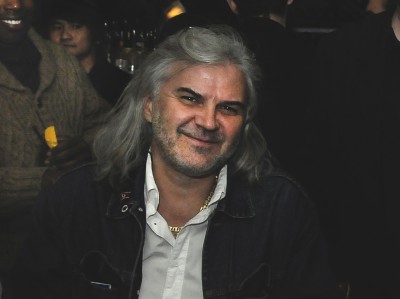
Robert Gardner, Susan Meiselas, William Rothman & Charles Warren
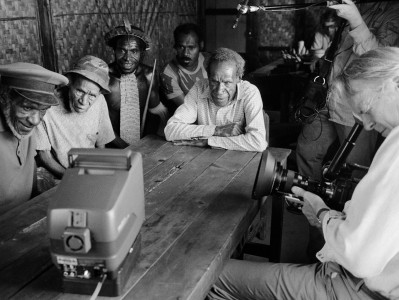
Stephanie Spray & Pacho Velez
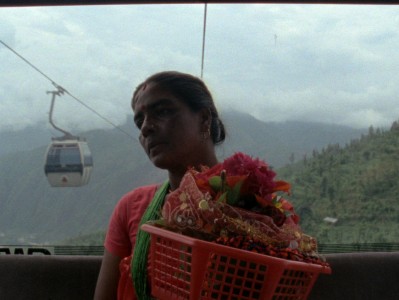
Masha Matzke & Sarah Keller
